
 Highly Recommended **** Billed as a “cult classic”, Tracy Letts’ 1996 play “Bug” has been revived by the Steppenwolf Theatre, marking that venue’s return to live audiences after the COVID-19 break. Horror, self-destruction, and psychological trauma prevail in this reprise, popular twenty months ago just before the pandemic closed down live entertainment in Chicago.
Highly Recommended **** Billed as a “cult classic”, Tracy Letts’ 1996 play “Bug” has been revived by the Steppenwolf Theatre, marking that venue’s return to live audiences after the COVID-19 break. Horror, self-destruction, and psychological trauma prevail in this reprise, popular twenty months ago just before the pandemic closed down live entertainment in Chicago.
“Bug” is a story about characters who are fractured and cannot find peace within themselves. The underlying theme is reminiscent of the old trope: “Just because you’re paranoid doesn’t mean they’re not out to get you.” Peter Evans (Namir Smallwood), a veteran of the 1991 Gulf War, eventually moves in Agnes “Aggie” White (Carrie Coon), who lives in a cheap motel room. It is unclear whether Peter suffers from PTSD or was the military’s unwilling medical experiment (think Agent Orange in Vietnam). Perhaps he partook in too many illegal drugs and now suffers from hallucinations and uncontrolled itching. Or maybe there was something organically wrong with him as a result of his tour of duty that makes him choose to self-medicate. Whatever the cause of his mental or emotional instability, Peter becomes increasingly obsessed about his involvement in the war and dwells somewhat too much on bombings and suicides and on Timothy McVeigh, Ted Kaczynski, and Jim Jones. Then there is Aggie, his girlfriend, who carries her own emotional baggage since her divorce—and yet remains in a dysfunctional relationship with her now ex-husband Jerry Goss (Steve Key). It was Aggie’s girlfriend R.C. (Jennifer Engstrom) who has introduced her to Peter, the drifter, and now he introduces her to the possible existence of bugs in her motel room.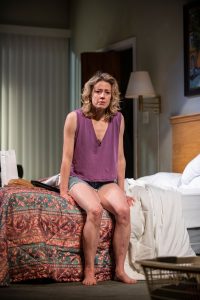
Peter is obsessed with bugs. He is convinced that real life aphids are attacking him, especially during the night. He bitterly complains of bug bites and purchases a microscope to examine the bugs and show how they feast on his blood. But as the story develops, the audience begins to wonder: Are the bugs real or solely in his imagination? There is no evidence of any bugs in any of the other motel rooms. But if they are real—and limited to their room only—then where are they coming from? It is then that we, the audience, go down the proverbial rabbit hole with them and peer behind the proverbial looking-glass. But do we really want to see the things that we see?
As the action focuses more tightly on Peter and Aggie’s relationship and his power of suggestion over her, that is the moment when we in the audience reflect on our ambivalence towards them. How could she have come down with the same symptoms as he has? We see their physical and emotional scars, but can we take their perceptions and their analysis at face-value? Do they live in a world of their own making—and are we simply getting a peek into their alternate way of viewing reality? As Aggie gives more and more credence to Peter’s ways of thinking and feeling, the audience no longer finds their quirkiness and sometimes bizarre behavior funny, and that’s when the horror sets in. Although we never learn the true origins of Peter’s confused (if not deranged) thinking, the possibility that this show raises is a very interesting one: that of sharing and spreading a collective delusion.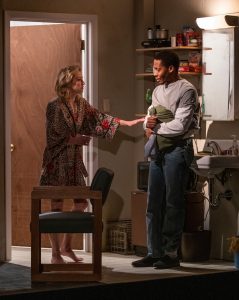
Had I seen the play in 2020 before the COVID shutdown, I might have had a different impression of it. But today, I am projecting a 2021 perspective onto a 1996 script, which at points makes the script seem prescient, while in other spots a bit dated. Allow me to explain.
These days, I find that too many people have “drunk from the Kool-Aid” and believe in wild conspiracy theories off the internet, whether these are grounded in reality or not. Sometimes the more incredibly far-fetched these “revelations” are (as those by Q-Anon), the more likely they will resonate with a certain segment of the American people. In “Bug” the collective delusion is limited to Peter spreading it to Aggie but apparently to nobody else. Today with social media, people are flocking together on the internet to share similar paranoias, prejudices, and odd—and even very dangerous—beliefs concerning the validity of our democracy and the uses of violence and hate; hence, we are facing a much larger menace than what we see on stage. Today small fringes of society have been given a megaphone together with considerable power and sway over their followers and the media; what they say is so outrageous that it becomes of notable interest. Had Peter and Aggie had access to a wide social media platform back in 1996, they most likely would have gotten other people involved in their efforts to promote their off-kilter and troubling worldview. They might have worked with them not only to remedy their frustrations but also to foment violent rebellion.
The ultimate irony of attending “Bug” at the Steppenwolf Theatre is this: Here we have audience members having to show proof of vaccination at the door and having to fully mask themselves during the performance. This is not only due to city and county ordinance but also in recognition of the authority of Dr. Anthony Fauci, the physician-scientist and immunologist who currently serves as the director of the National Institute of Allergy and Infectious Diseases and as Chief Medical Advisor to the President. In “Bug”, we see Dr. Sweet (Randall Arney) vow that he’d care for Peter and help him through his illness, while at the same time, the audience finds itself asking: Can we trust him or not? Or is this a con to take Peter back to some horrible medical experiment? How do we know he’s really a doctor? How do we know he has the cure? Similarly, there are those who revile Dr. Fauci and consider the vaccine to be a hoax, with the injection secretly implanting microchips (or nanoparticles) into a person’s body so that “they” (the government or the conspiratorial doctors) can take control. Interesting how Peter says something very similar to this in the course of the show! These same people who are against the vaccine also believe that masking in public places is a horrible conspiracy to infringe on our rights and our civil liberties. Again, a large part of Peter’s paranoid thinking has to do with the notion that the government creates sinister channels to demonstrate its power over us.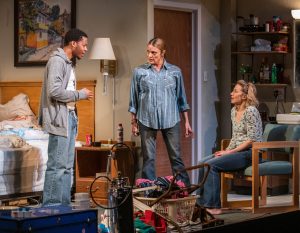
The scenic design by Takeshi Kata excels. The motel room is depicted beautifully, and the two main sets are different with a twist. I adore the tin foil walls in the second act—and especially how well they reflect the brightly colored lights, thanks to the lighting design by Heather Gilbert. I love the sharp angles, spotlights, and colors that highlight the emotions of the main characters as the play progresses. Very cleverly done! The sound design by Josh Schmidt is great. He uses sound to intensify the action, and this is especially powerful at the end. The costume design by Sarah Laux is thoughtful and accurate. What is more notable, however, is the use of nudity, although it wasn’t entirely clear whether this is necessary for the plot to work. In brief, it is the artistry that makes this production extraordinary and draws us in, that is, in addition to the nicely tailored but highly demanding script, splendid acting, and brilliant directing.
Director David Cromer, who guided the show during the first press performance on Thursday, November 11th, had to leave Chicago early to work on his next project. Therefore, he handed the reins over to the stage manager, cast, and crew for the second press performance on Tuesday the 16th. Thus the night I watched the show, it was apparent that the production ran like a fine mechanism, a well-oiled engine that can stand on its own. Kudos to Christine D. Freeburg and all those who took the proverbial ball and ran with it—with great effect.
“Bug” is playing at the Steppenwolf Theatre, 1650 N. Halsted Street, in Chicago, through December 12, 2021.
Running time is two hours with one intermission.
Single tickets are $20 – $110.
Discounts are available, including new Artists & Essential Workers discount, Pay-Your-Age performances, $5 teen tickets through the Teen Arts Pass, and many more options.
Performance schedule:
Tuesdays, Wednesdays, Thursdays, and Fridays – 8:00 p.m. (No performance on Thursday, November 25)
Wednesday matinee performances – 2:30 p.m. (No matinee performance on Wednesday, November 24)
Saturdays and Sundays – 3:00 and 8:00 p.m. (Final performance on December 12 at 3:00 p.m. only)
Accessible performances:
Open captioned: Thursday, November 18 at 8:00 p.m. and Saturday, December 11 at 3:00 p.m.
ASL interpreted: Sunday, November 28 at 8:00 p.m.
Audio-described and touch tour: Sunday, December 5 at 3:00 p.m. (1:30 p.m. touch tour, 3:00 p.m. curtain)
Additionally, Steppenwolf offers four reduced capacity performances for “Bug”, seating every other row and one seat on either side of each party:
Sunday, November 21 at 8:00 p.m., Wednesday, November 24 at 8:00 p.m., and Wednesday matinees December 1 and 8 at 2:30 p.m.
Tickets can be purchased through the website at: https://www.steppenwolf.org/tickets–events/seasons/2021-22/bug/ or the box office at 312-335-1650.
For general information or to learn about Steppenwolf’s other offerings, please go to: https://www.steppenwolf.org/.
Steppenwolf is part of the coalition of Chicagoland performing arts venues in requiring all patrons to be masked and show proof of COVID-19 vaccination (card and ID) or a negative test upon entry. For details, visit: https://www.steppenwolf.org/welcomeback.
To see what others are saying, visit www.theatreinchicago.com, go to Review Round-Up and click at “Bug”.

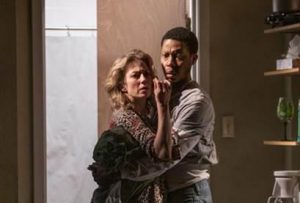
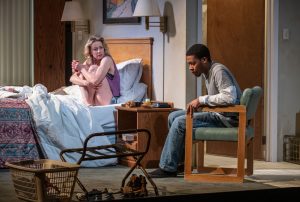




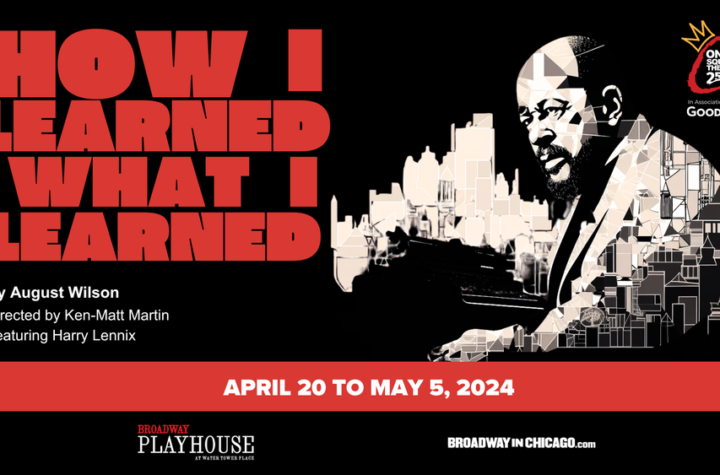
More Stories
“Barefoot in the Park”
“Joe Turner’s Come and Gone”
“How I Learned What I Learned” reviewed by Julia W. Rath